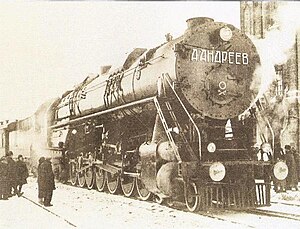
A bogie is a chassis or framework that carries a wheelset, attached to a vehicle—a modular subassembly of wheels and axles. Bogies take various forms in various modes of transport. A bogie may remain normally attached or be quickly detachable. It may include a suspension component within it, or be solid and in turn be suspended ; it may be mounted on a swivel, as traditionally on a railway carriage or locomotive, additionally jointed and sprung, or held in place by other means.

A steam locomotive is a locomotive that provides the force to move itself and other vehicles by means of the expansion of steam. It is fuelled by burning combustible material to heat water in the locomotive's boiler to the point where it becomes gaseous and its volume increases 1,700 times. Functionally, it is a steam engine on wheels.
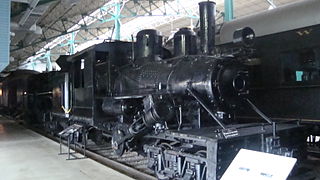
A Climax locomotive is a type of geared steam locomotive built by the Climax Manufacturing Company, of Corry, Pennsylvania. These had two steam cylinders attached to a transmission located under the center of the boiler, which sent power to driveshafts running to the front and rear trucks. Some 1,000-1,100 were built in three classes between 1888 and 1928.
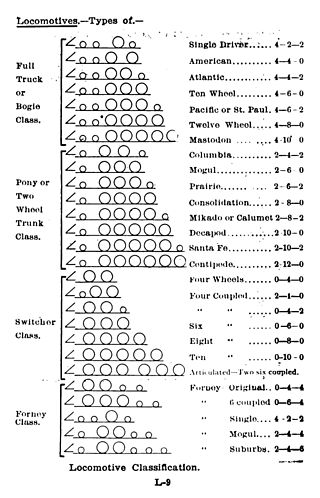
The Whyte notation is a classification method for steam locomotives, and some internal combustion locomotives and electric locomotives, by wheel arrangement. It was devised by Frederick Methvan Whyte, and came into use in the early twentieth century following a December 1900 editorial in American Engineer and Railroad Journal.

Under the Whyte notation for the classification of steam locomotives, a 2-10-4 locomotive has two leading wheels on one axle, usually in a Bissel truck, ten coupled driving wheels on five axles, and four trailing wheels on two axles, usually in a bogie. These were referred to as the Texas type in most of the United States, the Colorado type on the Burlington Route, and the Selkirk type in Canada.

Under the Whyte notation for the classification of steam locomotives, 4-8-4 represents the wheel arrangement of four leading wheels on two axles, eight powered and coupled driving wheels on four axles and four trailing wheels on two axles. The type was first used by the Northern Pacific Railway, and initially named the Northern Pacific, but railfans and railroad employees have shortened the name since its introduction. It is most-commonly known as a Northern.

Orenstein & Koppel was a major German engineering company specialising in railway vehicles, escalators, and heavy equipment. It was founded on April 1, 1876, in Berlin by Benno Orenstein and Arthur Koppel.

Main components found on a typical steam locomotive include:

Under the Whyte notation for the classification of steam locomotives, 4-2-0 represents the wheel arrangement of four leading wheels on two axles, two powered driving wheels on one axle and no trailing wheels. This type of locomotive is often called a Jervis type, the name of the original designer.

Under the Whyte notation, a 2-8-4 is a steam locomotive that has two unpowered leading wheels, followed by eight coupled and powered driving wheels, and four trailing wheels. This locomotive type is most often referred to as a Berkshire, though the Chesapeake and Ohio Railway used the name Kanawha for their 2-8-4s. In Europe, this wheel arrangement was mostly seen in mainline passenger express locomotives and, in certain countries, in tank locomotives.

Under the Whyte notation for the classification of steam locomotives, 4-2-2 represents the wheel arrangement of four leading wheels on two axles, two powered driving wheels on one axle, and two trailing wheels on one axle.
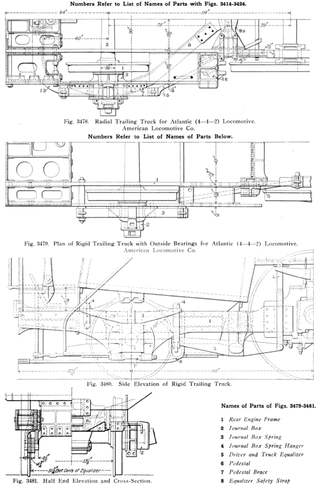
On a steam locomotive, a trailing wheel or trailing axle is generally an unpowered wheel or axle (wheelset) located behind the driving wheels. The axle of the trailing wheels is usually located in a trailing truck. On some large locomotives, a booster engine was mounted on the trailing truck to provide extra tractive effort when starting a heavy train and at low speeds on gradients.
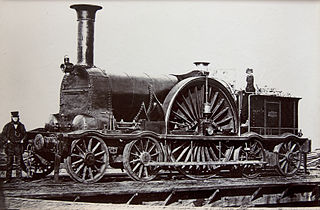
Under the Whyte notation for the classification of steam locomotives, 4-2-4 represents the wheel arrangement of four leading wheels on two axles, two powered driving wheels on one axle, and four trailing wheels on two axles.
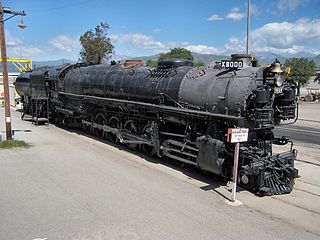
The Union Pacific Railroad 9000 Class was a class of 88 steam locomotives, built by ALCO for the Union Pacific between 1926 and 1930.

An adhesion railway relies on adhesion traction to move the train, and is the most widespread and common type of railway in the world. Adhesion traction is the friction between the drive wheels and the steel rail. Since the vast majority of railways are adhesion railways, the term adhesion railway is used only when it is necessary to distinguish adhesion railways from railways moved by other means, such as by a stationary engine pulling on a cable attached to the cars or by a pinion meshing with a rack.

London and North Western Railway (LNWR) 2-2-2 No. 3020 Cornwall is a preserved steam locomotive. She was built as a 4-2-2 at Crewe Works in 1847, but was extensively rebuilt and converted into her current form in 1858.

The South African Railways Class 21 2-10-4 of 1937 was a class of steam locomotives used in South Africa.

A 2-4-6-2 steam locomotive, in the Whyte notation for describing locomotive wheel arrangements, has a two-wheel leading truck, one set of four driving wheels, one set of six driving wheels, and a two-wheel trailing truck.
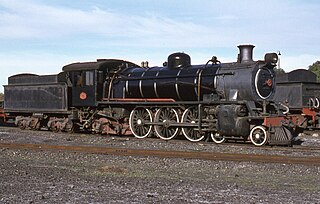
The South African Railways Class 5 4-6-2 of 1912 was a steam locomotive.

The Soviet locomotive class P36 was a Soviet mainline passenger steam locomotive type. Between 1950 and 1956, 251 locomotives were built. The locomotives were nicknamed "Generals" because of the red stripe down the side. The P36 had the same power as a class IS locomotive but the axle loading of 18 tons allowed its use on the vast majority of Russian railway lines, replacing class Su 2-6-2s and significantly increasing the weight of passenger trains. The P36 was the last type of mainline steam locomotive built in the Russian SFSR and the last one built, P36-0251, was the last steam locomotive produced by Kolomna Works, Russian SFSR. Though sometimes described as the "Victory" type locomotive, that nick-name actually belongs to the class L 2-10-0 built between 1945 and 1947.
